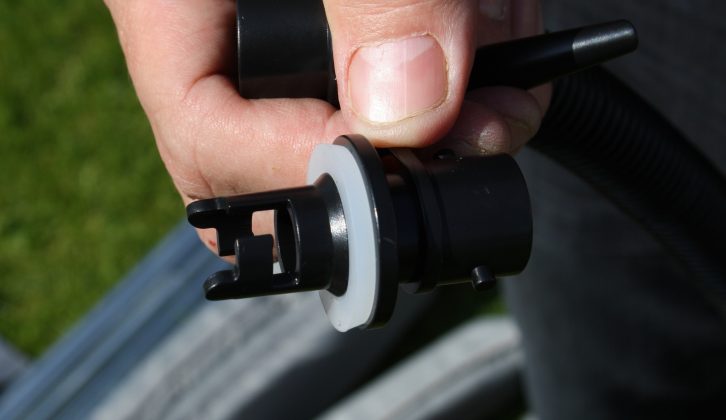Growth is being driven by consumer demand for quicker and easier awnings that do not threaten marriages
Given the time it takes to put them up and pack them away, awnings may not always be on the shopping list of caravanners who like to keep on the move. And, let’s face it, the image of awnings has never been well-served by the wag who memorably described them as “a divorce in a bag”. But that quip is starting to look more and more irrelevant.
A new generation of inflatable awnings has taken the market by storm in the past few years, conferring several benefits: they are light, pack up small, and can be assembled or disassembled in a matter of minutes.
 Watch the video
Watch the videoThere will always be demand for conventional, pole-frame awnings, in particular among those who stay on-site for long periods of time, such as seasonal-pitch users. However, for those who want to maximise relaxation time on site or prefer to visit several sites during one touring holiday, inflatables may be the way to go.
Available for tourers of all sizes, inflatable awnings have come of age. The technology has improved, cutting prices and boosting sales, and has proved particularly popular when used for porch awnings – creating a handy place to leave gear that you may not need on day trips.
Having friends to stay at short notice but only have two berths? No problem – they can sleep in the awning; some models have discreet ‘bedrooms’ that can be added. You can even fit canopies and annexes so there’s no need to fall over each other in the van – simply take the party outside!
All pumped up
Like a traditional pole awning, inflatables are attached to the caravan by feeding the beading into the awning rail. Then all that’s required is to inflate the support ‘beams’ using the supplied pump, and peg it in place. This process is just as easy in reverse, so you’ll be back on the road in no time.
The big names in tents and awnings have embraced the inflatable-awnings revolution and, over the past year, we have reviewed a selection of them. (You can read our Practical Caravan awning reviews online.) But what do the leading manufacturers have to say about how the market has grown?
It started with a tent
“When we launched our AirBeam tents in 2011, we knew we had a successful product range on our hands,” explains Emma Robinson, brand manager for Vango. “What we didn’t expect was the instant demand for us to produce inflatable awnings as well. There would be hundreds of people at NEC shows asking us if we were going to launch caravan awnings and drive-away versions for motorhomes, too.
“Since then, we’ve developed and perfected the fundamental design by producing easy-to-use valve systems and low-pressure, robust, double-sleeve beam systems to improve simplicity, cut costs and greatly reduce pitching time. Growth is being driven by consumer demand for quicker and easier awnings that do not threaten marriages when pitched on a Friday evening!”
Nigel Ainger from SunnFlair agrees: “Air technology has been around for a while but was very expensive. The full-awning market seems to be in regression because of the perceived high cost, so the porch market has grown, and air technology makes using a porch awning easier.”
In pole position
Like other companies in the industry, SunnFlair is converting its most popular pole-supported awnings into inflatable models. There is a price difference, says Nigel, but he believes this will narrow as inflatable technology matures: “Air awnings tend to be copies of what’s already in a given range. You get a proven design but with the poles replaced by inflatable tubes. As prices fall, I expect manufacturers to get a little bolder with their designs.”
Clive Garrett from Outwell reckons that inflatables’ ease of use and convenience makes them irresistible: “Materials and designs have been time-proven and fine-tuned for tents before seeping into the awning market. Potential buyers have seen how easy it is to pitch large inflatable tents for families and want the same convenience. Plus, of course, an inflatable tube will do less damage than a pole if there is an accident.”
Garrett sees plenty of room for innovation in a market that is still growing. “We could add features,” he says, “but ease and convenience appear to be the priorities. Even simpler erection and packing away may be the key areas to concentrate on.”
Winning over buyers
SunnFlair’s Ainger says inflatable awnings are attracting new buyers: “Take potential customers who haven’t had either and show them both. They’ll go for the inflatable every time.”
Vango’s Emma Robinson agrees that the convenience of an inflatable is the essence of its appeal: “Buyers appreciate the flexibility to move at a moment’s notice, knowing that pitching and packing are not going to take hours. Some customers get their children or grandchildren to do most of the work, because it’s fun and simple to do!”
Our top six inflatable awnings for caravans
In Practical Caravan we regularly test new caravan accessories as they are launched and these are our top six inflatable awnings for 2015 and 2016 so far.
Vango Varkala 420, priced at £725. Test published: September 2015 issue. Verdict: 4.5 stars.
Outwell Pacific Coast, priced at £549.99. Test published: December 2015 issue. Verdict: 4 stars.
Outdoor Revolution Compact AirLite 340, priced at £839.99. Test published: October 2015 issue. Verdict: 4 stars.
Westfield Easy Air 350, priced at £299.99. Test published: August 2015 issue. Verdict 3.5 stars.
SunnCamp Ultima Air 390 Deluxe, priced at £710. Test published February 2016 issue. Verdict 3.5 stars.
Kampa Fiesta Air Pro 280, priced at £787. Test published: March 2016 issue. Verdict 3.5 stars.





























